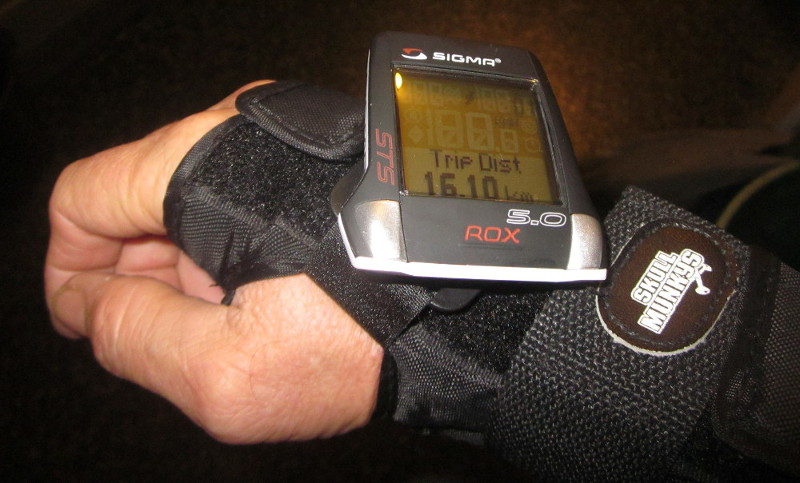Without handlebars, mounting a cycle computer in visible location on a uni just isn’t possible. Wrist mounting and a wireless sensor system is an alternative.
I bought a Sigma ROX 5 with wireless speed, cadence and heart rate sensors. It comes with a wrist mount but it is configured to automatically suppress the cycling functions when mounted this way. I contemplated rewiring wrist mount contacts to the cycling configuration but found a better solution.
In an “undocumented feature”, the back of the cycle mount happens to snap very securely inside the hole in the wrist mount. This not only solves the configuration issue but affords full 360 degree continuous rotation to the computer. The cycle mount is also far more sturdy than the wrist mount.
The back of the arrangement isn’t entirely smooth so would need some kind of a backing added if it were to be worn on a bare wrist. I wear wrist guards so it doesn’t matter because the reinforcement in the guard does the job.
However I found it quite difficult to put the supplied band on around the wrist guard. My solution to this was to strap the mount to the wrist guard with a short piece of hook-side velcro passing through the thumb hole and around the outside of the guard. It attached itself securely to the furry-side velcro on the guard and lining inside the guard.
Moreover with using the piggybacked mounts, the computer sat somewhat proud around the wrist. Where I mounted it, the computer sits lower in the bend of the guard.
The speed and cadence sensors are designed to project a beam towards the computer, so need to be directed appropriately. It also made sense to mount the computer on the hand that usually held the seat handle and aim the sensors toward it.
As mounted on the front of the right fork in the photo, the (upper) cadence sensor points considerably forwards of the seat while the (lower) speed sensor is almost at the maximum recommended distance from the computer. I wasn’t expecting them to work if I waved my arm about but testing from riding position I was not able to put my wrist anywhere that lost the signal from either sensor. Perhaps the signal is less attenuated in the absence of a big conducting handlebar right under the computer.
I found it easy to read the speed while rising but cadence and lap digits are a little small.
The ROX 5 has an extensive range of features including 100 lap timing and ten second interval recording that can be downloaded to a computer with an optional adaptor and software. Two cycles can be recorded independently. The cadence sensor has a setting which allows the computer to recognise the sensor and sync with the correct logging system.
The ROX 6 includes a barometric altimeter too. With a slightly larger screen the buttons below the screen have been moved onto the bottom edge and might be a prone to accidental operation in some positions. I will probably try one of these units some time rather than just buying a second set of sensors to use on another uni.
Those who require GPS functionality could consider a ROX 10. I didn’t look hard enough into its specs but I know some GPS enabled cycle computers rely on GPS for speed and distance rather than a wheel sensor. As such they can miss corners and are less accurate. Moreover it might start to become a bit large for wrist mounting.





